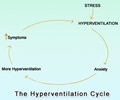A recent research by UI psychology professors Gregory A. Miller and Wendy Heller has found that brain activity reflects differences in types of anxiety.
Researchers, whose work will be published this month online in Psychophysiology, have found the most convincing confirmation yet of contrary patterns of brain activity connected with each of two types of anxiety: anxious apprehension (verbal rumination, worry) and anxious arousal (intense fear, panic, or both).“This study looks at two facets of anxiety that often are not distinguished. We had reason to think there were different brain mechanisms, different parts of the brain active at different times, depending on what type of anxiety one is facing,” said U. of I. psychology professor Gregory A. Miller.
According to a recent national survey, anxiety disorders are the most regularly reported psychiatric disorders in the U.S. The Diagnostic and Statistical Manual of Mental Disorders classifies almost a dozen different anxiety disorders, from severe stress disorder to obsessive-compulsive disorder to panic attack and PTSD.
But those who study and treat patients with anxiety disorders do not always distinguish the patients who worry, are hassled and ruminate from those who experience the panic, rapid heartbeat or bouts of sweating that describe anxious arousal. These two kinds of anxiety may occur alone or in combination, with potentially significant implications for treatment.
To test whether neural activation patterns supported the hypothesis that these two categories of anxiety are different, the researchers chose 42 subjects from a group of 1,099 undergraduate college students, using psychological tests to classify them as “high anxious apprehension,” “high anxious arousal,” or neither.
Other psychological assessments standardized the group of participants by eliminating those with mood disorders or other complicating factors.
Advertisement
As the researchers had expected, the anxious apprehension group displayed enhanced left-brain activity and the anxious arousal group had heightened activity in the right brain. The anxious apprehension group exhibited augmented activity in a region of the left inferior frontal lobe that is linked to speech production. The anxious arousal group had more activity in a region of the right-hemisphere inferior temporal lobe that is believed to be occupied with tracking and responding to information signaling danger.
Advertisement
Miller stressed the importance of a related finding: The researchers distinguished the left-brain region involved in anxious apprehension from a nearby structure that is associated with positive emotional processing.
“Left and right is not the only distinction we made,” Miller said. “We did left/right comparisons with groups, but we also did comparisons within the left hemisphere to show that these different areas are doing different things.”
“This is biological validation of the proposal of the psychological differentiation of types of anxiety,” Miller said. “Whether you want to treat anxiety psychologically or biologically – and we know that either type of intervention affects both the psychology and the biology of the person – these findings are a reminder that you might want to assess people carefully before you embark on a particular type of treatment.”
The study was supported mainly by the National Institute of Mental Health and also by the National Institute on Drug Abuse, both at the National Institutes of Health. Support also was provided by the Beckman Institute, the department of psychology and the Intercampus Research Initiative on Biotechnology at the U. of I.
Source: ANI
LIN/M











